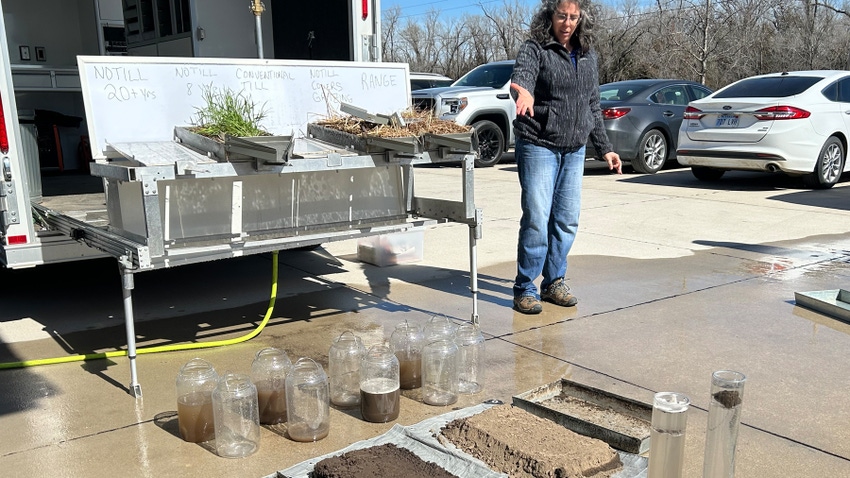
Time is a luxury farmers don’t often have.
It takes three to five years to see results from implementing regenerative agricultural practices, both in the field and in the ledger book. That gap of time before a return on investment is realized can often be a stumbling point for farmers who are considering implementing regenerative agricultural practices.
ADM’s Re:generations program is meant to help producers bridge that gap.
It’s not a carbon-credit program like many farmers may be familiar with, according to company officials. Instead, they say, it’s taking a more holistic approach to soil health and regenerative agriculture by paying farmers to execute regenerative ag practices on their farms.
ADM has been in the regenerative ag space for a decade, says Lauren Sprung, product manager for regenerative agriculture and specialty products. In that time, the company saw that there was a need to focus on the bigger environmental picture just beyond a carbon credit.
And, in 2022, Re:generations was rolled out to meet that need.
“We’re focused on holistic improved soil health, and a lot of times regenerative ag gets focused on carbon reduction, but it’s much more than that,” Sprung says. “It’s about improving biodiversity, increasing water quality, making sure that soil stays in place so it still helps reduce soil erosion — all of those things.”
ADM brought a group of Kansas farmers together March 5 in Hutchinson, Kan., to go over how Re:generations might fit into their operation.
How it works
Farmers are paid on a per-acre basis depending on what regenerative ag practices they use on their enrolled acres. They can enroll as many acres as they wish, but those acres cannot already be enrolled in another private regenerative ag program. Farmers can participate in government programs, such as EQIP for funding conservation tools, for example.
Farmers who are eligible to enroll in the Re:generations program grow corn, soybeans, wheat, canola or peanuts.
Currently, the regenerative ag practices covered include growing cover crops, adopting no-till or strip-till, keeping living roots on the soil all year or double cropping, and practicing nutrient management.
So far, the program is open in Illinois, Indiana, Iowa, Kansas, Michigan, Minnesota, Missouri, Nebraska, North Carolina, North Dakota, Ohio, Oklahoma, Alabama, Florida, Georgia, Mississippi, South Carolina and Washington. More states and more commodities may be added later.
Enrollment starts with a short conversation with a technical assistant partner or ADM climate-smart origination manager.
ADM is working with the Farmers Business Network’s Gradable to gather the basic field-level data from farmers in a secure fashion. For example, is the farmer using no-till or reduced tillage? How long have they been using that practice? What’s their fertilizer program? Do they plant cover crops? What are the field boundaries and field IDs? And what crops do they raise?
FBN verifies the practices that farmers are using through remote sensing and other tools, and then, in March the following year, ADM will pay the farmer.
Farmer benefits
Getting paid by the acre for certain practices is one thing, but there are other benefits to the program for enrolling, farmers say.
First, there’s not a huge penalty to farmers who’ve been implementing these tools for years and aren’t new to the regenerative ag space. That was one of the things that drew Kendall Hodgson, of Little River, Kan., to enroll some of his wheat acres last year.
“We’re going to get paid for what we’re doing anyway,” he says. “We feel strongly about soil conservation and making things last into future generations, and if we can monetize that, that’s so much better.”
At the end of the year, they also receive some information on how they might improve their practices.
Another benefit of the program is that it doesn’t require identity preservation of the grain enrolled.
“We don’t require that the wheat enrolled in Re:generations is delivered to an ADM facility, although of course we do ask for a last look, but because it’s mass balance, that’s why we have that flexibility,” Sprung says. “Our customers know where they’re getting their flour, and that mill is sourcing their wheat, and we can trace and connect that back to [a supply shed]. So while we might not again be getting the exact wheat grown, we are touching that supply shed and impacting change.”
There is no one-size-fits-all solution, and there are risks to implementing these farming practices, Sprung says.
This incentive program helps farmers pay for the costs they incur implementing the regenerative ag practices they choose on their farms, whether that’s the cost of no-till equipment, cover crop seed or other costs, Sprung explains.
“The whole goal is to partner with the farmers on their journey to improve soil health,” Sprung says.
Sharing insights
“We are uniquely positioned in the value chain to deliver value to both ends of the supply chain,” Sprung says. “So you have farmers that are farming in a new way, and there’s risk associated with that, and so we’re looking to de-risk that and add value to them.”
She explains that how a farmer grows their crop today has value beyond the market price of that commodity. The value is in the story of how that grain was grown.
The field-level data is collected and secured by FBN — no field-level data is shared to ADM or its customers. But the aggregated and anonymized data has helpful applications, such as showing grain buyers what practices are prevalent in a particular grain shed where they’re sourcing their grain.
Representatives from Nestle and Grupo Bimbo, two multinational companies that source grain from ADM, were on hand to talk about how knowing this information helps them communicate to their customers that they are buying from grain sheds that have a certain level of regenerative ag practices being conducted.
Tim Wallenhorst, senior brand manager for DiGiorno, a brand of Nestle, says the company is investing in the regenerative ag space for the wheat it sources for its pizza crusts because it’s something that consumers can understand.
While there’s no label on the package, it starts a conversation about how the company is responsibly sourcing its ingredients with consumers.
Hodgson said what he appreciates about this program as a farmer is the emphasis on education and peer-to-peer networking it provides.
“I think we’re seeing a proliferation of these programs,” he says. “I think the education is helpful to bring everyone along [and] to work with various groups to learn how to get proper practices that we know are better for the environment, better for our soil, better for our communities and better for our families.”
About the Author(s)
You May Also Like






